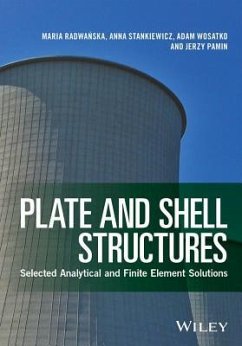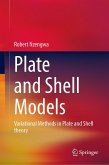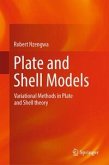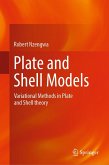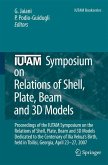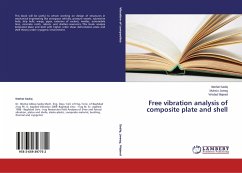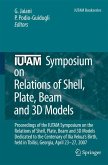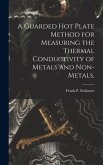Radwa &, Anna Stankiewicz, Adam Wosatko, Jerzy Pamin
Plate and Shell Structures
Selected Analytical and Finite Element Solutions
Radwa &, Anna Stankiewicz, Adam Wosatko, Jerzy Pamin
Plate and Shell Structures
Selected Analytical and Finite Element Solutions
- Gebundenes Buch
- Merkliste
- Auf die Merkliste
- Bewerten Bewerten
- Teilen
- Produkt teilen
- Produkterinnerung
- Produkterinnerung
Plate and Shell Structures: Selected Analytical and Finite Element Solutions Maria Radwañska, Anna Stankiewicz, Adam Wosatko, Jerzy Pamin Cracow University of Technology, Poland Comprehensively covers the fundamental theory and analytical and numerical solutions for different types of plate and shell structures Plate and Shell Structures: Selected Analytical and Finite Element Solutions not only provides the theoretical formulation of fundamental problems of mechanics of plates and shells, but also several examples of analytical and numerical solutions for different types of shell structures.…mehr
Andere Kunden interessierten sich auch für
![Plate and Shell Models Plate and Shell Models]() Robert NzengwaPlate and Shell Models62,99 €
Robert NzengwaPlate and Shell Models62,99 €![Plate and Shell Models Plate and Shell Models]() Robert NzengwaPlate and Shell Models92,00 €
Robert NzengwaPlate and Shell Models92,00 €![Plate and Shell Models Plate and Shell Models]() Robert NzengwaPlate and Shell Models66,99 €
Robert NzengwaPlate and Shell Models66,99 €![IUTAM Symposium on Relations of Shell, Plate, Beam and 3D Models IUTAM Symposium on Relations of Shell, Plate, Beam and 3D Models]() IUTAM Symposium on Relations of Shell, Plate, Beam and 3D Models77,99 €
IUTAM Symposium on Relations of Shell, Plate, Beam and 3D Models77,99 €![Free vibration analysis of composite plate and shell Free vibration analysis of composite plate and shell]() Ibtehal SadiqFree vibration analysis of composite plate and shell49,99 €
Ibtehal SadiqFree vibration analysis of composite plate and shell49,99 €![IUTAM Symposium on Relations of Shell, Plate, Beam and 3D Models IUTAM Symposium on Relations of Shell, Plate, Beam and 3D Models]() IUTAM Symposium on Relations of Shell, Plate, Beam and 3D Models77,99 €
IUTAM Symposium on Relations of Shell, Plate, Beam and 3D Models77,99 €![A Guarded Hot Plate Method for Measuring the Thermal Conductivity of Metals and Non-metals. A Guarded Hot Plate Method for Measuring the Thermal Conductivity of Metals and Non-metals.]() Frank P SchlosserA Guarded Hot Plate Method for Measuring the Thermal Conductivity of Metals and Non-metals.35,99 €
Frank P SchlosserA Guarded Hot Plate Method for Measuring the Thermal Conductivity of Metals and Non-metals.35,99 €-
-
-
Plate and Shell Structures: Selected Analytical and Finite Element Solutions Maria Radwañska, Anna Stankiewicz, Adam Wosatko, Jerzy Pamin Cracow University of Technology, Poland Comprehensively covers the fundamental theory and analytical and numerical solutions for different types of plate and shell structures Plate and Shell Structures: Selected Analytical and Finite Element Solutions not only provides the theoretical formulation of fundamental problems of mechanics of plates and shells, but also several examples of analytical and numerical solutions for different types of shell structures. The book contains advanced aspects related to stability analysis and a brief description of modern finite element formulations for plates and shells, including the discussion of mixed/hybrid models and locking phenomena. Key features: * 52 example problems solved and illustrated by more than 200 figures, including 30 plots of finite element simulation results. * Contents based on many years of research and teaching the mechanics of plates and shells to students of civil engineering and professional engineers. * Provides the basis of an intermediate-level course on computational mechanics of shell structures. The book is essential reading for engineering students, university teachers, practitioners and researchers interested in the mechanics of plates and shells, as well as developers testing new simulation software.
Hinweis: Dieser Artikel kann nur an eine deutsche Lieferadresse ausgeliefert werden.
Hinweis: Dieser Artikel kann nur an eine deutsche Lieferadresse ausgeliefert werden.
Produktdetails
- Produktdetails
- Verlag: Wiley
- Seitenzahl: 424
- Erscheinungstermin: 6. Februar 2017
- Englisch
- Abmessung: 246mm x 168mm x 25mm
- Gewicht: 794g
- ISBN-13: 9781118934548
- ISBN-10: 1118934547
- Artikelnr.: 47489131
- Herstellerkennzeichnung
- Libri GmbH
- Europaallee 1
- 36244 Bad Hersfeld
- gpsr@libri.de
- Verlag: Wiley
- Seitenzahl: 424
- Erscheinungstermin: 6. Februar 2017
- Englisch
- Abmessung: 246mm x 168mm x 25mm
- Gewicht: 794g
- ISBN-13: 9781118934548
- ISBN-10: 1118934547
- Artikelnr.: 47489131
- Herstellerkennzeichnung
- Libri GmbH
- Europaallee 1
- 36244 Bad Hersfeld
- gpsr@libri.de
Maria Radwañska, recently professor emeritus, worked for over 40 years at the Faculty of Civil Engineering of Cracow University of Technology, first at the Institute of Structural Mechanics, then at the Institute for Computational Civil Engineering. She has done research on statics and stability of elastic and elastic-plastic bars, plates and shells. She was a teacher of structural mechanics, theory of plates and shells, theory of stability and computational methods (including finite element method) at the level of doctoral, graduate and undergraduate studies, as well as at training courses for professional engineers. She is the author or co-author of seven monographs, books and textbooks, and of numerous journal papers. She was a member of the research team of Prof. Zenon Waszczyszyn, who implemented the FE Code ANKA for buckling and nonlinear analysis of structures and wrote in 1994 the Elsevier book on FEM for stability of structures. She received numerous awards from the Minister of Science and Higher Education of Poland. Anna Stankiewicz, lecturer at the Institute for Computational Civil Engineering, Cracow University of Technology. She has taught computational methods, engineering graphics, computer science, mechanics of materials and structures, and since 2008 succeeded M. Radwañska as lecturer of the theory of plates and shells (both in the courses in Polish and English). She was the coordinator and lecturer in training courses on Shell Structures - modelling and FEM analysis and on Computational Methods in Civil Engineering, organized for professional engineers in years 2010-15 within EU Human Capital Operational Programme. Currently she is also involved in the research on thermoplasticity. Adam Wosatko, assistant professor at the Institute for Computational Civil Engineering, Cracow University of Technology. He has taught applied mathematics and numerical methods, computational methods, engineering graphics, computer science, mechanics of materials and structures, and the theory of plates and shells (both in the courses in Polish and English). He was the lecturer in training courses on Shell Structures - modelling and FEM analysis and on Computational Methods in Civil Engineering, organized for professional engineers in years 2010-14 within EU Human Capital Operational Programme. In 2014-15 post-doc at the Department of Civil and Environmental Engineering of University of Waterloo, Canada. Currently also involved in the research on the mechanics of structures in fire. Jerzy Pamin, professor of Cracow University of Technology (CUT), since 2006 head of the Institute for Computational Civil Engineering. He was Ph.D. student at Faculty of Civil Engineering, Delft University of Technology, the Netherlands, where he obtained a Ph.D. in 1994 on the basis of broadly cited dissertation on Gradient-Dependent Plasticity in Numerical Simulation of Localization Phenomena, written under the supervision of R. de Borst. Since then he has been employed at CUT, in 1998-99 post-doc at Koiter Institute Delft, in 2002 Humboldt Fellow at the University of Kaiserslautern, Germany. In 2004 he obtained a D.Sc. degree at CUT for the monograph on Gradient-enhanced continuum models: formulation, discretization and applications, for which he won the M.T. Huber award of Division for Technical Sciences of the Polish Academy of Sciences in 2007. His field of expertise is mechanics of generalized continua and FE simulations in mechanics of materials and structures. He has taught mechanics of materials and structures, computational methods and advanced FEM (both in the courses in Polish and English), and coordinated of an undergraduate civil engineering course in English.
Preface xvii
Notation xix
Part 1 Fundamentals: Theory and Modelling 1
1 General Information 3
1.1 Introduction 3
1.2 Review of Theories Describing Elastic Plates and Shells 6
1.3 Description of Geometry for 2D Formulation 9
1.4 Definitions and Assumptions for 2D Formulation 16
1.5 Classification of Shell Structures 21
References 24
2 Equations for Theory of Elasticity for 3D Problems 26
Reference 30
3 Equations of Thin Shells According to the Three-Parameter Kirchhoff-Love
Theory 31
3.1 General Equations for Thin Shells 31
3.2 Specification of Lame Parameters and Principal Curvature Radii for
Typical Surfaces 38
3.3 Transition from General Shell Equations to Particular Cases of Plates
and Shells 42
3.4 Displacement Equations for Multi-Parameter Plate and Shell Theories 45
3.5 Remarks 47
References 47
4 General Information about Models and Computational Aspects 48
4.1 Analytical Approach to Statics, Buckling and Free Vibrations 49
4.2 Approximate Approach According to the Finite Difference Method 51
4.3 Computational Analysis by Finite Element Method 54
4.4 Computational Models - Summary 55
Reference 55
5 Description of Finite Elements for Analysis of Plates and Shells 56
5.1 General Information on Finite Elements 56
5.2 Description of Selected FEs 58
5.3 Remarks on Displacement-based FE Formulation 69
References 70
Part 2 Plates 73
6 Flat Rectangular Membranes 75
6.1 Introduction 75
6.2 Governing Equations 76
6.3 Square Membrane under Unidirectional Tension 81
6.4 Square Membrane under Uniform Shear 83
6.5 Pure In-Plane Bending of a Square Membrane 85
6.6 Cantilever Beam with a Load on the Free Side 88
6.7 Rectangular Deep Beams 94
6.8 Membrane with Variable Thicknesses or Material Parameters 97
References 101
7 Circular and Annular Membranes 102
7.1 Equations of Membranes - Local and Global Formulation 102
7.2 Equations for the Axisymmetric Membrane State 104
7.3 Annular Membrane 105
References 109
8 Rectangular Plates under Bending 110
8.1 Introduction 110
8.2 Equations for the Classical Kirchhoff-Love Thin Plate Theory 110
8.3 Derivation of Displacement Equation for a Thin Plate from the Principle
of Minimum Potential Energy 117
8.4 Equation for a Plate under Bending Resting on a Winkler Elastic
Foundation 118
8.5 Equations of Mindlin-Reissner Moderately Thick Plate Theory 119
8.6 Analytical Solution of a Sinusoidally Loaded Rectangular Plate 122
8.7 Analysis of Plates under Bending Using Expansions in Double or Single
Trigonometric Series 127
8.8 Simply Supported or Clamped Square Plate with Uniform Load 131
8.9 Rectangular Plate with a Uniform Load and Various Boundary Conditions -
Comparison of STSM and FEM Results 135
8.10 Uniformly Loaded Rectangular Plate with Clamped and Free Boundary
Lines - Comparison of STSM and FEM Results 139
8.11 Approximate Solution to a Plate Bending Problem using FDM 143
8.12 Approximate Solution to a Bending Plate Problem using the Ritz Method
151
8.13 Plate with Variable Thickness 153
8.14 Analysis of Thin and Moderately Thick Plates in Bending 155
References 159
9 Circular and Annular Plates under Bending 160
9.1 General State 160
9.2 Axisymmetric State 162
9.3 Analytical Solution using a Trigonometric Series Expansion 164
9.4 Clamped Circular Plate with a Uniformly Distributed Load 166
9.5 Simply Supported Circular Plate with a Concentrated Central Force 169
9.6 Simply Supported Circular Plate with an Asymmetric Distributed Load 171
9.7 Uniformly Loaded Annular Plate with Static and Kinematic Boundary
Conditions 174
References 177
Part 3 Shells 179
10 Shells in the Membrane State 181
10.1 Introduction 181
10.2 General Membrane State in Shells of Revolution 182
10.3 Axisymmetric Membrane State 183
10.4 Hemispherical Shell 186
10.5 Open Conical Shell under Self Weight 193
10.6 Cylindrical Shell 195
10.7 Hemispherical Shell with an Asymmetric Wind Action 199
References 204
11 Shells in the Membrane-Bending State 205
11.1 Cylindrical Shells 205
11.2 Spherical Shells 221
11.3 Cylindrical and Spherical Shells Loaded by a Uniformly Distributed
Boundary Moment and Horizontal Force 229
11.4 Cylindrical Shell with a Spherical Cap - Analytical and Numerical
Solution 232
11.5 General Case of Deformation of Cylindrical Shells 237
11.6 Cylindrical Shell with a Semicircular Cross Section under Self Weight
- Analytical Solution of Membrane State 238
11.7 Cylindrical Scordelis-Lo Roof in the Membrane-Bending State -
Analytical and Numerical Solution 242
11.8 Single-Span Clamped Horizontal Cylindrical Shell under Self Weight 246
References 254
12 Shallow Shells 256
12.1 Equations for Shallow Shells 256
12.2 Pucher's Equations for Shallow Shells in the Membrane State 260
12.3 Hyperbolic Paraboloid with Rectangular Projection 262
12.4 Remarks on Engineering Applications 266
References 267
13 Thermal Loading of Selected Membranes, Plates and Shells 268
13.1 Introduction 268
13.2 Uniform Temperature Change along the Thickness 270
13.3 Linear Temperature Change along the Thickness - Analytical Solutions
275
References 286
Part 4 Stability and Free Vibrations 287
14 Stability of Plates and Shells 289
14.1 Overview of Plate and Shell Stability Problems 289
14.2 Basis of Linear Buckling Theory, Assumptions and Computational Models
291
14.3 Description of Physical Phenomena and Nonlinear Simulations in
Stability Analysis 298
14.4 Analytical and Numerical Buckling Analysis for Selected Plates and
Shells 301
14.5 Snap-Through and Snap-Back Phenomena Observed for Elastic Shallow
Cylindrical Shells in Geometrically Nonlinear Analysis 319
References 321
15 Free Vibrations of Plates and Shells 323
15.1 Introduction 323
15.2 Natural Transverse Vibrations of a Thin Rectangular Plate 325
15.3 Parametric Analysis of Free Vibrations of Rectangular Plates 328
15.4 Natural Vibrations of Cylindrical Shells 333
15.5 Remarks 337
References 338
Part 5 Aspects of FE Analysis 339
16 Modelling Process 341
16.1 Advantages of Numerical Simulations 341
16.2 Complexity of Shell Structures Affecting FEM 342
16.3 Particular Requirements for FEs in Plate and Shell Discretization 343
References 346
17 Quality of FEs and Accuracy of Solutions in Linear Analysis 347
17.1 Order of Approximation Function versus Order of Numerical Integration
Quadrature 347
17.2 Assessment of Element Quality via Spectral Analysis 347
17.3 Numerical Effects of Shear Locking and Membrane Locking 350
17.4 Examination of Element Quality - One-Element and Patch Tests 354
17.5 Benchmarks for Membranes and Plates 357
17.6 Benchmarks for Shells 359
17.7 Comparison of Analytical and Numerical Solutions, Application of
Various FE Formulations 361
References 362
18 Advanced FE Formulations 365
18.1 Introduction 365
18.2 Link between Variational Formulations and FE Models 366
18.3 Advanced FEs 373
References 383
A List of Boxes with Equations 387
B List of Boxes with Data and Results for Examples 389
Index 391
Notation xix
Part 1 Fundamentals: Theory and Modelling 1
1 General Information 3
1.1 Introduction 3
1.2 Review of Theories Describing Elastic Plates and Shells 6
1.3 Description of Geometry for 2D Formulation 9
1.4 Definitions and Assumptions for 2D Formulation 16
1.5 Classification of Shell Structures 21
References 24
2 Equations for Theory of Elasticity for 3D Problems 26
Reference 30
3 Equations of Thin Shells According to the Three-Parameter Kirchhoff-Love
Theory 31
3.1 General Equations for Thin Shells 31
3.2 Specification of Lame Parameters and Principal Curvature Radii for
Typical Surfaces 38
3.3 Transition from General Shell Equations to Particular Cases of Plates
and Shells 42
3.4 Displacement Equations for Multi-Parameter Plate and Shell Theories 45
3.5 Remarks 47
References 47
4 General Information about Models and Computational Aspects 48
4.1 Analytical Approach to Statics, Buckling and Free Vibrations 49
4.2 Approximate Approach According to the Finite Difference Method 51
4.3 Computational Analysis by Finite Element Method 54
4.4 Computational Models - Summary 55
Reference 55
5 Description of Finite Elements for Analysis of Plates and Shells 56
5.1 General Information on Finite Elements 56
5.2 Description of Selected FEs 58
5.3 Remarks on Displacement-based FE Formulation 69
References 70
Part 2 Plates 73
6 Flat Rectangular Membranes 75
6.1 Introduction 75
6.2 Governing Equations 76
6.3 Square Membrane under Unidirectional Tension 81
6.4 Square Membrane under Uniform Shear 83
6.5 Pure In-Plane Bending of a Square Membrane 85
6.6 Cantilever Beam with a Load on the Free Side 88
6.7 Rectangular Deep Beams 94
6.8 Membrane with Variable Thicknesses or Material Parameters 97
References 101
7 Circular and Annular Membranes 102
7.1 Equations of Membranes - Local and Global Formulation 102
7.2 Equations for the Axisymmetric Membrane State 104
7.3 Annular Membrane 105
References 109
8 Rectangular Plates under Bending 110
8.1 Introduction 110
8.2 Equations for the Classical Kirchhoff-Love Thin Plate Theory 110
8.3 Derivation of Displacement Equation for a Thin Plate from the Principle
of Minimum Potential Energy 117
8.4 Equation for a Plate under Bending Resting on a Winkler Elastic
Foundation 118
8.5 Equations of Mindlin-Reissner Moderately Thick Plate Theory 119
8.6 Analytical Solution of a Sinusoidally Loaded Rectangular Plate 122
8.7 Analysis of Plates under Bending Using Expansions in Double or Single
Trigonometric Series 127
8.8 Simply Supported or Clamped Square Plate with Uniform Load 131
8.9 Rectangular Plate with a Uniform Load and Various Boundary Conditions -
Comparison of STSM and FEM Results 135
8.10 Uniformly Loaded Rectangular Plate with Clamped and Free Boundary
Lines - Comparison of STSM and FEM Results 139
8.11 Approximate Solution to a Plate Bending Problem using FDM 143
8.12 Approximate Solution to a Bending Plate Problem using the Ritz Method
151
8.13 Plate with Variable Thickness 153
8.14 Analysis of Thin and Moderately Thick Plates in Bending 155
References 159
9 Circular and Annular Plates under Bending 160
9.1 General State 160
9.2 Axisymmetric State 162
9.3 Analytical Solution using a Trigonometric Series Expansion 164
9.4 Clamped Circular Plate with a Uniformly Distributed Load 166
9.5 Simply Supported Circular Plate with a Concentrated Central Force 169
9.6 Simply Supported Circular Plate with an Asymmetric Distributed Load 171
9.7 Uniformly Loaded Annular Plate with Static and Kinematic Boundary
Conditions 174
References 177
Part 3 Shells 179
10 Shells in the Membrane State 181
10.1 Introduction 181
10.2 General Membrane State in Shells of Revolution 182
10.3 Axisymmetric Membrane State 183
10.4 Hemispherical Shell 186
10.5 Open Conical Shell under Self Weight 193
10.6 Cylindrical Shell 195
10.7 Hemispherical Shell with an Asymmetric Wind Action 199
References 204
11 Shells in the Membrane-Bending State 205
11.1 Cylindrical Shells 205
11.2 Spherical Shells 221
11.3 Cylindrical and Spherical Shells Loaded by a Uniformly Distributed
Boundary Moment and Horizontal Force 229
11.4 Cylindrical Shell with a Spherical Cap - Analytical and Numerical
Solution 232
11.5 General Case of Deformation of Cylindrical Shells 237
11.6 Cylindrical Shell with a Semicircular Cross Section under Self Weight
- Analytical Solution of Membrane State 238
11.7 Cylindrical Scordelis-Lo Roof in the Membrane-Bending State -
Analytical and Numerical Solution 242
11.8 Single-Span Clamped Horizontal Cylindrical Shell under Self Weight 246
References 254
12 Shallow Shells 256
12.1 Equations for Shallow Shells 256
12.2 Pucher's Equations for Shallow Shells in the Membrane State 260
12.3 Hyperbolic Paraboloid with Rectangular Projection 262
12.4 Remarks on Engineering Applications 266
References 267
13 Thermal Loading of Selected Membranes, Plates and Shells 268
13.1 Introduction 268
13.2 Uniform Temperature Change along the Thickness 270
13.3 Linear Temperature Change along the Thickness - Analytical Solutions
275
References 286
Part 4 Stability and Free Vibrations 287
14 Stability of Plates and Shells 289
14.1 Overview of Plate and Shell Stability Problems 289
14.2 Basis of Linear Buckling Theory, Assumptions and Computational Models
291
14.3 Description of Physical Phenomena and Nonlinear Simulations in
Stability Analysis 298
14.4 Analytical and Numerical Buckling Analysis for Selected Plates and
Shells 301
14.5 Snap-Through and Snap-Back Phenomena Observed for Elastic Shallow
Cylindrical Shells in Geometrically Nonlinear Analysis 319
References 321
15 Free Vibrations of Plates and Shells 323
15.1 Introduction 323
15.2 Natural Transverse Vibrations of a Thin Rectangular Plate 325
15.3 Parametric Analysis of Free Vibrations of Rectangular Plates 328
15.4 Natural Vibrations of Cylindrical Shells 333
15.5 Remarks 337
References 338
Part 5 Aspects of FE Analysis 339
16 Modelling Process 341
16.1 Advantages of Numerical Simulations 341
16.2 Complexity of Shell Structures Affecting FEM 342
16.3 Particular Requirements for FEs in Plate and Shell Discretization 343
References 346
17 Quality of FEs and Accuracy of Solutions in Linear Analysis 347
17.1 Order of Approximation Function versus Order of Numerical Integration
Quadrature 347
17.2 Assessment of Element Quality via Spectral Analysis 347
17.3 Numerical Effects of Shear Locking and Membrane Locking 350
17.4 Examination of Element Quality - One-Element and Patch Tests 354
17.5 Benchmarks for Membranes and Plates 357
17.6 Benchmarks for Shells 359
17.7 Comparison of Analytical and Numerical Solutions, Application of
Various FE Formulations 361
References 362
18 Advanced FE Formulations 365
18.1 Introduction 365
18.2 Link between Variational Formulations and FE Models 366
18.3 Advanced FEs 373
References 383
A List of Boxes with Equations 387
B List of Boxes with Data and Results for Examples 389
Index 391
Preface xvii
Notation xix
Part 1 Fundamentals: Theory and Modelling 1
1 General Information 3
1.1 Introduction 3
1.2 Review of Theories Describing Elastic Plates and Shells 6
1.3 Description of Geometry for 2D Formulation 9
1.4 Definitions and Assumptions for 2D Formulation 16
1.5 Classification of Shell Structures 21
References 24
2 Equations for Theory of Elasticity for 3D Problems 26
Reference 30
3 Equations of Thin Shells According to the Three-Parameter Kirchhoff-Love
Theory 31
3.1 General Equations for Thin Shells 31
3.2 Specification of Lame Parameters and Principal Curvature Radii for
Typical Surfaces 38
3.3 Transition from General Shell Equations to Particular Cases of Plates
and Shells 42
3.4 Displacement Equations for Multi-Parameter Plate and Shell Theories 45
3.5 Remarks 47
References 47
4 General Information about Models and Computational Aspects 48
4.1 Analytical Approach to Statics, Buckling and Free Vibrations 49
4.2 Approximate Approach According to the Finite Difference Method 51
4.3 Computational Analysis by Finite Element Method 54
4.4 Computational Models - Summary 55
Reference 55
5 Description of Finite Elements for Analysis of Plates and Shells 56
5.1 General Information on Finite Elements 56
5.2 Description of Selected FEs 58
5.3 Remarks on Displacement-based FE Formulation 69
References 70
Part 2 Plates 73
6 Flat Rectangular Membranes 75
6.1 Introduction 75
6.2 Governing Equations 76
6.3 Square Membrane under Unidirectional Tension 81
6.4 Square Membrane under Uniform Shear 83
6.5 Pure In-Plane Bending of a Square Membrane 85
6.6 Cantilever Beam with a Load on the Free Side 88
6.7 Rectangular Deep Beams 94
6.8 Membrane with Variable Thicknesses or Material Parameters 97
References 101
7 Circular and Annular Membranes 102
7.1 Equations of Membranes - Local and Global Formulation 102
7.2 Equations for the Axisymmetric Membrane State 104
7.3 Annular Membrane 105
References 109
8 Rectangular Plates under Bending 110
8.1 Introduction 110
8.2 Equations for the Classical Kirchhoff-Love Thin Plate Theory 110
8.3 Derivation of Displacement Equation for a Thin Plate from the Principle
of Minimum Potential Energy 117
8.4 Equation for a Plate under Bending Resting on a Winkler Elastic
Foundation 118
8.5 Equations of Mindlin-Reissner Moderately Thick Plate Theory 119
8.6 Analytical Solution of a Sinusoidally Loaded Rectangular Plate 122
8.7 Analysis of Plates under Bending Using Expansions in Double or Single
Trigonometric Series 127
8.8 Simply Supported or Clamped Square Plate with Uniform Load 131
8.9 Rectangular Plate with a Uniform Load and Various Boundary Conditions -
Comparison of STSM and FEM Results 135
8.10 Uniformly Loaded Rectangular Plate with Clamped and Free Boundary
Lines - Comparison of STSM and FEM Results 139
8.11 Approximate Solution to a Plate Bending Problem using FDM 143
8.12 Approximate Solution to a Bending Plate Problem using the Ritz Method
151
8.13 Plate with Variable Thickness 153
8.14 Analysis of Thin and Moderately Thick Plates in Bending 155
References 159
9 Circular and Annular Plates under Bending 160
9.1 General State 160
9.2 Axisymmetric State 162
9.3 Analytical Solution using a Trigonometric Series Expansion 164
9.4 Clamped Circular Plate with a Uniformly Distributed Load 166
9.5 Simply Supported Circular Plate with a Concentrated Central Force 169
9.6 Simply Supported Circular Plate with an Asymmetric Distributed Load 171
9.7 Uniformly Loaded Annular Plate with Static and Kinematic Boundary
Conditions 174
References 177
Part 3 Shells 179
10 Shells in the Membrane State 181
10.1 Introduction 181
10.2 General Membrane State in Shells of Revolution 182
10.3 Axisymmetric Membrane State 183
10.4 Hemispherical Shell 186
10.5 Open Conical Shell under Self Weight 193
10.6 Cylindrical Shell 195
10.7 Hemispherical Shell with an Asymmetric Wind Action 199
References 204
11 Shells in the Membrane-Bending State 205
11.1 Cylindrical Shells 205
11.2 Spherical Shells 221
11.3 Cylindrical and Spherical Shells Loaded by a Uniformly Distributed
Boundary Moment and Horizontal Force 229
11.4 Cylindrical Shell with a Spherical Cap - Analytical and Numerical
Solution 232
11.5 General Case of Deformation of Cylindrical Shells 237
11.6 Cylindrical Shell with a Semicircular Cross Section under Self Weight
- Analytical Solution of Membrane State 238
11.7 Cylindrical Scordelis-Lo Roof in the Membrane-Bending State -
Analytical and Numerical Solution 242
11.8 Single-Span Clamped Horizontal Cylindrical Shell under Self Weight 246
References 254
12 Shallow Shells 256
12.1 Equations for Shallow Shells 256
12.2 Pucher's Equations for Shallow Shells in the Membrane State 260
12.3 Hyperbolic Paraboloid with Rectangular Projection 262
12.4 Remarks on Engineering Applications 266
References 267
13 Thermal Loading of Selected Membranes, Plates and Shells 268
13.1 Introduction 268
13.2 Uniform Temperature Change along the Thickness 270
13.3 Linear Temperature Change along the Thickness - Analytical Solutions
275
References 286
Part 4 Stability and Free Vibrations 287
14 Stability of Plates and Shells 289
14.1 Overview of Plate and Shell Stability Problems 289
14.2 Basis of Linear Buckling Theory, Assumptions and Computational Models
291
14.3 Description of Physical Phenomena and Nonlinear Simulations in
Stability Analysis 298
14.4 Analytical and Numerical Buckling Analysis for Selected Plates and
Shells 301
14.5 Snap-Through and Snap-Back Phenomena Observed for Elastic Shallow
Cylindrical Shells in Geometrically Nonlinear Analysis 319
References 321
15 Free Vibrations of Plates and Shells 323
15.1 Introduction 323
15.2 Natural Transverse Vibrations of a Thin Rectangular Plate 325
15.3 Parametric Analysis of Free Vibrations of Rectangular Plates 328
15.4 Natural Vibrations of Cylindrical Shells 333
15.5 Remarks 337
References 338
Part 5 Aspects of FE Analysis 339
16 Modelling Process 341
16.1 Advantages of Numerical Simulations 341
16.2 Complexity of Shell Structures Affecting FEM 342
16.3 Particular Requirements for FEs in Plate and Shell Discretization 343
References 346
17 Quality of FEs and Accuracy of Solutions in Linear Analysis 347
17.1 Order of Approximation Function versus Order of Numerical Integration
Quadrature 347
17.2 Assessment of Element Quality via Spectral Analysis 347
17.3 Numerical Effects of Shear Locking and Membrane Locking 350
17.4 Examination of Element Quality - One-Element and Patch Tests 354
17.5 Benchmarks for Membranes and Plates 357
17.6 Benchmarks for Shells 359
17.7 Comparison of Analytical and Numerical Solutions, Application of
Various FE Formulations 361
References 362
18 Advanced FE Formulations 365
18.1 Introduction 365
18.2 Link between Variational Formulations and FE Models 366
18.3 Advanced FEs 373
References 383
A List of Boxes with Equations 387
B List of Boxes with Data and Results for Examples 389
Index 391
Notation xix
Part 1 Fundamentals: Theory and Modelling 1
1 General Information 3
1.1 Introduction 3
1.2 Review of Theories Describing Elastic Plates and Shells 6
1.3 Description of Geometry for 2D Formulation 9
1.4 Definitions and Assumptions for 2D Formulation 16
1.5 Classification of Shell Structures 21
References 24
2 Equations for Theory of Elasticity for 3D Problems 26
Reference 30
3 Equations of Thin Shells According to the Three-Parameter Kirchhoff-Love
Theory 31
3.1 General Equations for Thin Shells 31
3.2 Specification of Lame Parameters and Principal Curvature Radii for
Typical Surfaces 38
3.3 Transition from General Shell Equations to Particular Cases of Plates
and Shells 42
3.4 Displacement Equations for Multi-Parameter Plate and Shell Theories 45
3.5 Remarks 47
References 47
4 General Information about Models and Computational Aspects 48
4.1 Analytical Approach to Statics, Buckling and Free Vibrations 49
4.2 Approximate Approach According to the Finite Difference Method 51
4.3 Computational Analysis by Finite Element Method 54
4.4 Computational Models - Summary 55
Reference 55
5 Description of Finite Elements for Analysis of Plates and Shells 56
5.1 General Information on Finite Elements 56
5.2 Description of Selected FEs 58
5.3 Remarks on Displacement-based FE Formulation 69
References 70
Part 2 Plates 73
6 Flat Rectangular Membranes 75
6.1 Introduction 75
6.2 Governing Equations 76
6.3 Square Membrane under Unidirectional Tension 81
6.4 Square Membrane under Uniform Shear 83
6.5 Pure In-Plane Bending of a Square Membrane 85
6.6 Cantilever Beam with a Load on the Free Side 88
6.7 Rectangular Deep Beams 94
6.8 Membrane with Variable Thicknesses or Material Parameters 97
References 101
7 Circular and Annular Membranes 102
7.1 Equations of Membranes - Local and Global Formulation 102
7.2 Equations for the Axisymmetric Membrane State 104
7.3 Annular Membrane 105
References 109
8 Rectangular Plates under Bending 110
8.1 Introduction 110
8.2 Equations for the Classical Kirchhoff-Love Thin Plate Theory 110
8.3 Derivation of Displacement Equation for a Thin Plate from the Principle
of Minimum Potential Energy 117
8.4 Equation for a Plate under Bending Resting on a Winkler Elastic
Foundation 118
8.5 Equations of Mindlin-Reissner Moderately Thick Plate Theory 119
8.6 Analytical Solution of a Sinusoidally Loaded Rectangular Plate 122
8.7 Analysis of Plates under Bending Using Expansions in Double or Single
Trigonometric Series 127
8.8 Simply Supported or Clamped Square Plate with Uniform Load 131
8.9 Rectangular Plate with a Uniform Load and Various Boundary Conditions -
Comparison of STSM and FEM Results 135
8.10 Uniformly Loaded Rectangular Plate with Clamped and Free Boundary
Lines - Comparison of STSM and FEM Results 139
8.11 Approximate Solution to a Plate Bending Problem using FDM 143
8.12 Approximate Solution to a Bending Plate Problem using the Ritz Method
151
8.13 Plate with Variable Thickness 153
8.14 Analysis of Thin and Moderately Thick Plates in Bending 155
References 159
9 Circular and Annular Plates under Bending 160
9.1 General State 160
9.2 Axisymmetric State 162
9.3 Analytical Solution using a Trigonometric Series Expansion 164
9.4 Clamped Circular Plate with a Uniformly Distributed Load 166
9.5 Simply Supported Circular Plate with a Concentrated Central Force 169
9.6 Simply Supported Circular Plate with an Asymmetric Distributed Load 171
9.7 Uniformly Loaded Annular Plate with Static and Kinematic Boundary
Conditions 174
References 177
Part 3 Shells 179
10 Shells in the Membrane State 181
10.1 Introduction 181
10.2 General Membrane State in Shells of Revolution 182
10.3 Axisymmetric Membrane State 183
10.4 Hemispherical Shell 186
10.5 Open Conical Shell under Self Weight 193
10.6 Cylindrical Shell 195
10.7 Hemispherical Shell with an Asymmetric Wind Action 199
References 204
11 Shells in the Membrane-Bending State 205
11.1 Cylindrical Shells 205
11.2 Spherical Shells 221
11.3 Cylindrical and Spherical Shells Loaded by a Uniformly Distributed
Boundary Moment and Horizontal Force 229
11.4 Cylindrical Shell with a Spherical Cap - Analytical and Numerical
Solution 232
11.5 General Case of Deformation of Cylindrical Shells 237
11.6 Cylindrical Shell with a Semicircular Cross Section under Self Weight
- Analytical Solution of Membrane State 238
11.7 Cylindrical Scordelis-Lo Roof in the Membrane-Bending State -
Analytical and Numerical Solution 242
11.8 Single-Span Clamped Horizontal Cylindrical Shell under Self Weight 246
References 254
12 Shallow Shells 256
12.1 Equations for Shallow Shells 256
12.2 Pucher's Equations for Shallow Shells in the Membrane State 260
12.3 Hyperbolic Paraboloid with Rectangular Projection 262
12.4 Remarks on Engineering Applications 266
References 267
13 Thermal Loading of Selected Membranes, Plates and Shells 268
13.1 Introduction 268
13.2 Uniform Temperature Change along the Thickness 270
13.3 Linear Temperature Change along the Thickness - Analytical Solutions
275
References 286
Part 4 Stability and Free Vibrations 287
14 Stability of Plates and Shells 289
14.1 Overview of Plate and Shell Stability Problems 289
14.2 Basis of Linear Buckling Theory, Assumptions and Computational Models
291
14.3 Description of Physical Phenomena and Nonlinear Simulations in
Stability Analysis 298
14.4 Analytical and Numerical Buckling Analysis for Selected Plates and
Shells 301
14.5 Snap-Through and Snap-Back Phenomena Observed for Elastic Shallow
Cylindrical Shells in Geometrically Nonlinear Analysis 319
References 321
15 Free Vibrations of Plates and Shells 323
15.1 Introduction 323
15.2 Natural Transverse Vibrations of a Thin Rectangular Plate 325
15.3 Parametric Analysis of Free Vibrations of Rectangular Plates 328
15.4 Natural Vibrations of Cylindrical Shells 333
15.5 Remarks 337
References 338
Part 5 Aspects of FE Analysis 339
16 Modelling Process 341
16.1 Advantages of Numerical Simulations 341
16.2 Complexity of Shell Structures Affecting FEM 342
16.3 Particular Requirements for FEs in Plate and Shell Discretization 343
References 346
17 Quality of FEs and Accuracy of Solutions in Linear Analysis 347
17.1 Order of Approximation Function versus Order of Numerical Integration
Quadrature 347
17.2 Assessment of Element Quality via Spectral Analysis 347
17.3 Numerical Effects of Shear Locking and Membrane Locking 350
17.4 Examination of Element Quality - One-Element and Patch Tests 354
17.5 Benchmarks for Membranes and Plates 357
17.6 Benchmarks for Shells 359
17.7 Comparison of Analytical and Numerical Solutions, Application of
Various FE Formulations 361
References 362
18 Advanced FE Formulations 365
18.1 Introduction 365
18.2 Link between Variational Formulations and FE Models 366
18.3 Advanced FEs 373
References 383
A List of Boxes with Equations 387
B List of Boxes with Data and Results for Examples 389
Index 391

